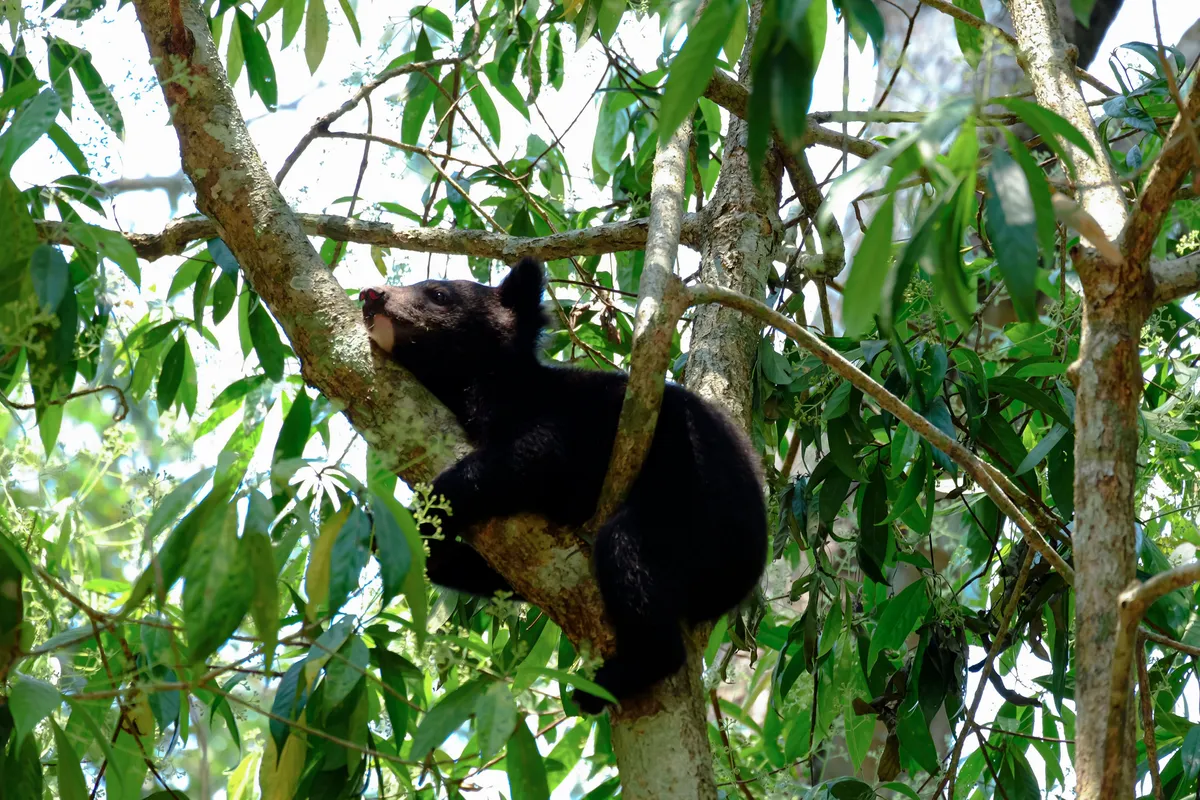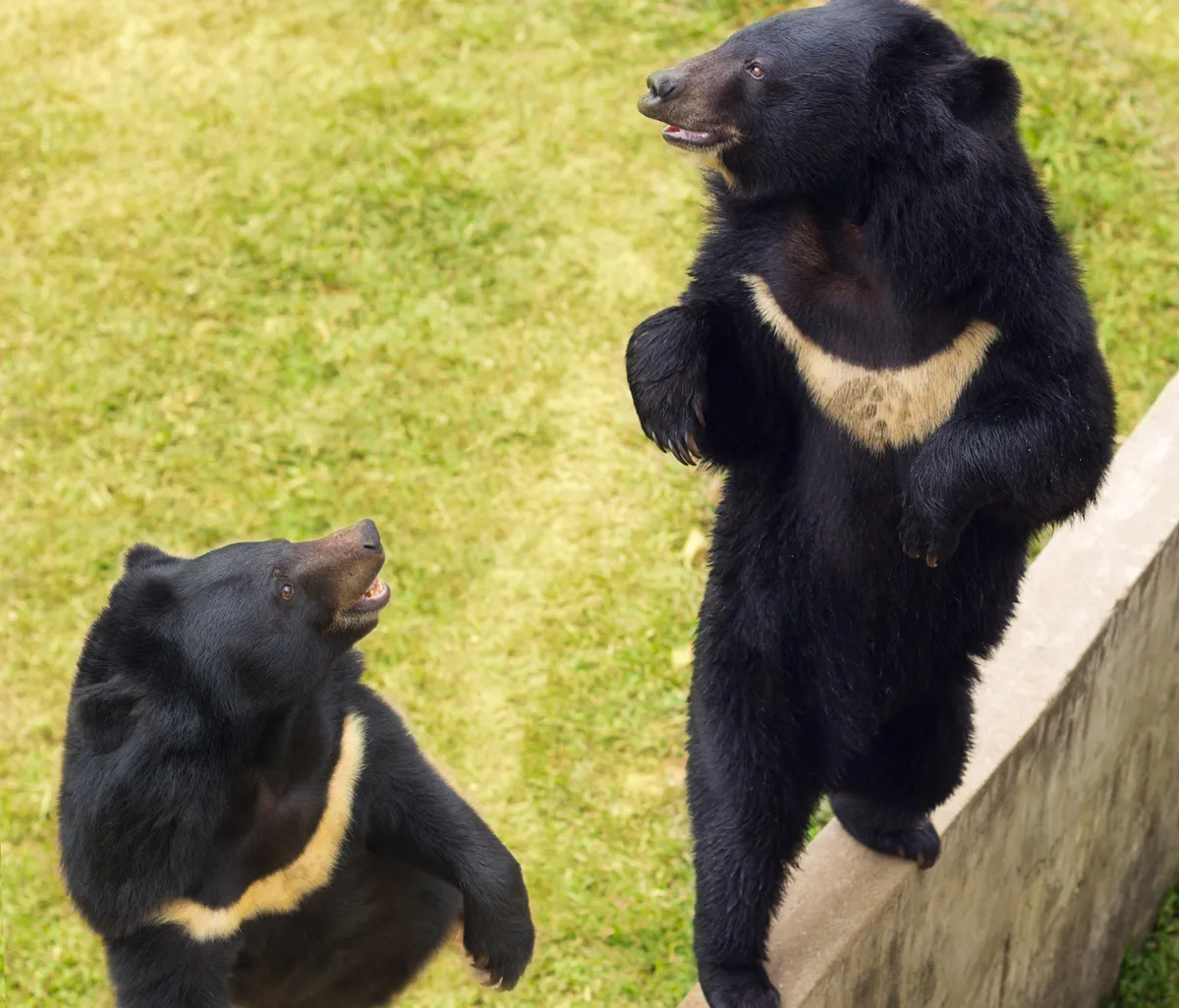Moon bears numbers continue to decline and we risk losing this enigmatic species, says Heidi Quine from Animals Asia. Learn all about moon bears in her expert guide
What are moon bears
The charismatic moon bear, or Asiatic black bear as it is otherwise known, is one of the least well-known of the eight bear species that share our planet
- What is the biggest bear in the world?
- This tiny, solitary bear can mimic facial expressions like humans – wait, what?
- Who is the real Paddington Bear? Meet the heartwarming bears of South America's cloud forests, who inspired a fictional icon
What do moon bears look like?
Moon bears are striking animals with dense black medium-length fur and prominent bell-shaped ears. Their coat pattern is as unique to each of them as our fingerprints are to us.
Females often, though not always, sport a shaggy rough of longer fur around their necks.
How big are moon bears?
Medium-sized bears between 137cm and 162cm, moon bears generally weigh 80-200kg.
Why are they called moon bears?
The are named moon bears after the crescent moon blaze of cream-coloured fur across their chest.
Where do moon bears live?

Moon bears inhabit diverse forests across Southeast Asia, extending north to Korea and Japan, and as far west as Iran and Pakistan. They can be found in broad-leafed and coniferous woodlands, ranging from sea level to elevations up to 4,300m. They are one of the world's largest tree-dwelling mammals and are excellent climbers, spending up to half of their lives in the trees .
Are they social?
Generally solitary creatures, moon bear mating occurs primarily in June and July, though bears have been observed showing mating behaviour as early as May. Female bears give birth to one or two cubs every other year between November and March.
How do moon bears communicate?
From grunts and whines to roars and slurping sounds, moon bears make various sounds in communicating with each other. Yet many of their vocalisations, such as a clucking 'tut tut' sound, are poorly understood.
What do moon bears eat?
Moon bears feast on fruits, berries, insects, small mammals and plants. The seeds of fruits and berries eaten by the bears pass through their digestive tracts intact and are then dispersed into the environment when the bears defecate. This form of seed dispersal is critical for the diversity and composition of forests.
One of the bears' most remarkable physiological adaptations is their ability to survive prolonged periods of food scarcity by gorging during times of abundance. In late spring and summer, bear appetites gradually increase, peaking roughly mid-autumn.
During this period of extreme calorie consumption, known as hyperphagia, bears can consume ten times as much as they ordinarily would. Favouring calorie-packed autumn mast such as nuts and seeds, bears can substantially increase their layer of insulating body fat, sometimes increasing their weight by up to a half.
In winter, hunger drives begin to wane before gradually dropping to their lowest levels in spring, when the annual cycle starts again. Especially in their northernmost populations, where winters are freezing and food is scarce, this cyclic feeding behaviour is critical for moon bears as hibernation and winter denning are necessary for survival. Interestingly, in the southernmost ranges of their habitat, where food is available all year round, moon bears don’t hibernate.
- Spirit bear facts you need to know
- Grizzly bear guide: where they live, how they hunt and conservation
- Black bear guide: how to identify, where to find them and what to do if you encounter one
- Polar bear guide: where they're found, what they eat, and why they're threatened
Are moon bears at risk?
Soberingly, the moon bear is listed as Vulnerable by the IUCN, meaning they are at high risk of extinction if conservation measures are not implemented. Across most of the moon bear's range, the actual number of moon bears left in the wild is unknown.
The Republic of Korea and Japan report increasing population numbers, while Bhutan and Thailand report stable populations. Across the rest of the moon bear's range, populations are in decline, with the most significant numbers lost in Bangladesh and Vietnam, where more than 60% of the wild population has been lost in the last 30 years alone (IUCN source).
What's the biggest threat to moon bears

The biggest threats to moon bears in the wild are logging, the expansion of plantations, and commercial hunting. However, the species is also threatened by its small population size and human-bear conflicts. As bear habitats reduce, bears are forced closer to human settlements, increasing their exposure to hunting pressures. One of the biggest drivers of commercial hunting is to meet the demand for bear bile, used in Traditional Asian Medicine.
Wild bears are trapped in the forest, often by snare or leghold traps, devices with wires or serrated steel jaws designed to indiscriminately trap (often by a paw or hoof) any hapless creature unlucky enough to misstep.
Snare traps are widespread in Vietnam, where wild moon bear populations have plummeted. These traps require minimal effort and costs, consisting of only wire, such as bicycle brake cables and materials like branches sourced from the forest.
The devastating impact of snare traps on wildlife has been compared to that of ocean-based drift nets, which also have the potential to obliterate wild animal populations indiscriminately.
Bears caught by snare traps often lose limbs or show other permanent disfigurement, such as partial circumference abdominal scarring. Many bears caught in snare traps likely end up on bear bile farms, where they may spend 20 years or more in cages not much bigger than their bodies.
Moon bears and bear bile farming
Bear bile farming was first developed in the 1980s in North Korea in a misguided attempt to conserve wild bears whose numbers were decimated by poaching to meet the demand for bear bile.
The idea was that breeding and farming captive bears would create a self-sustaining population, and several Asian countries, including Vietnam, adopted it. However, in this case and others, wildlife farming has been proven repeatedly to be detrimental to the species it aims to conserve, whether through the emergence of zoonotic diseases or creating opportunities to launder illegally caught wildlife.
Since the development of bear bile farming, wild bear numbers have plummeted in Vietnam. At its height in the mid-2000s, Vietnam saw a staggering 4,500 bears on farms across the country. Yet, no official records of bears bred on farms exist, implying that each bear was poached from the wild.
Today, in 2023, there are around 300 bears on Vietnamese farms, and the latest wild bear population research shows that all wild populations across the country are either in decline or have been locally extirpated.
What is being done to help moon bears?
A number of organisations work to end the illegal bear bile industry. For example, Vietnamese authorities often cite the lack of placement options for intercepted and confiscated wildlife as one of their most significant challenges in working to stop the illegal wildlife trade. To address this, Animals Asia operates two bear rescue sanctuaries in the country. The organisation hopes that by offering the Vietnamese authorities placement opportunities for every bear held on bear bile farms across the country, bear bile farming in Vietnam will end for good.
Meanwhile, Free the Bears has been working with San Diego Zoo Global on developing a behaviour change campaign to reduce demand for bear products in Cambodia.
Heidi Quine is Animal Asia's Vietnam Bear and Vet Department Director and heads up the bear care and veterinary department at Animal Asia's Vietnam Bear Rescue Centre. The charity has two bear sanctuaries, one in Tam Dao National Park and one in Bach Ma National Park.
Animals Asia is devoted to ending bear bile farming and improving the welfare of animals across Asia. They promote compassion and respect for all animals and work to bring about long-term change.
For more information about Animals Asia’s work, please visit animalsasia.org





